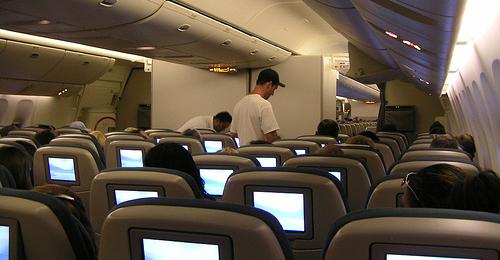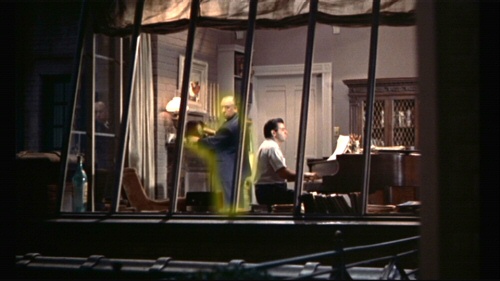B-B-B-Bennie (A Question Of Safety)

This is actually a question, but I’m going to phrase it in the form of a bit of imagineering:
It’s the future, but not by much, and you’re in a passenger jet.
Despite the fact that you’ve heard the instructions a hundred times previous, you’ve been a good customer and listened to the safety talk at the start of the flight – even though it meant having to strain to hear over the pair of teenage brothers arguing for the window seat in the next row. You’re feeling this was an especially good idea, as the tinny voice of the Captain has recently broken out from the speakers to inform you that the plane is currently suffering some technical issues.

Your suspicions that it might have something to do with the flaming engine on the left wing are well founded.
The harness you’ve buckled yourself into was a little unwieldy, but the low chime the jet’s computer made to indicate you’d done it properly was actually oddly soothing. The flight attendants continue to coo for everyone to remain calm, but you can’t stop staring at the roasting wing, and thinking about the first episode of LOST.
Without warning, the plane starts to lose altitude.
Thrashing your head around, you note that smoke is now also billowing from the opposite side of your conveyance.
For a brief moment, vocal anarchy breaks out. You can hear the teenage boys shrieking, even over the cacophony of sudden cursing and prayer, and your mind goes into a red panic at the idea that this might be your last breath.
In fact, the only thing that isn’t alarmed is the central brain, nicknamed Bennie, that the folks at Boeing have programmed and prepared for just such a situation. The machine doesn’t care if it’s narcing on bathroom smokers or preparing for a crash, it purrs along, unaffected. It runs some equations and decides that a proper landing is now impossible.
[youtube=http://www.youtube.com/watch?v=QjUk3Bp16zs]
Long seconds into the drop, there’s a quick series of pops, and a strip of roof running the length of the jet catches the wind and blows away, exposing the blue sky and clouds above.
The fluffy white puffs seem to be moving upwards at a terrible speed.
At 30,000 feet the seats start flying. The rapid fire process could never be controlled by a human hand, but Bennie has no issues with the micro-timing required to prevent mid-air impacts during the departures. By the 15,000 foot mark the tube is an empty egg carton, and the wind is full of parachutes.
You, the seat your buckled to, and your similarly situated fellow passengers, all begin the slow descent to the farmland below, feeling like the world’s laziest paratrooper invasion.
The plane’s final impact is spectacular, and your view of it will remain in your memory for the rest of your life.
Now, my question – why not?
 An odd thought came to me yesterday, pre-
An odd thought came to me yesterday, pre-

 If it were designed by NASA, Star Trek: The Next Generation would have probably just been Data exploring the depths of space while standing on the tip of a warp nacelle, watching passively through a bell jar which would double as a transporter when he finally arrived somewhere.
If it were designed by NASA, Star Trek: The Next Generation would have probably just been Data exploring the depths of space while standing on the tip of a warp nacelle, watching passively through a bell jar which would double as a transporter when he finally arrived somewhere.

 You’re familiar with the concept of a “juggernaut”?
You’re familiar with the concept of a “juggernaut”?

 No, not the fellow with the ethereal glow, that’s the film’s director making his usual cameo – no, the other, the musician who spends the film composing a song entitled “Lisa”.
No, not the fellow with the ethereal glow, that’s the film’s director making his usual cameo – no, the other, the musician who spends the film composing a song entitled “Lisa”. Allow me to ease your fears up front, the subject doesn’t refer to a bit of fan fiction I’m about to unleash.
Allow me to ease your fears up front, the subject doesn’t refer to a bit of fan fiction I’m about to unleash.
 Am I claiming that The Hardy Boys series is somehow the literary equivalent of Huckleberry Finn? No.
Am I claiming that The Hardy Boys series is somehow the literary equivalent of Huckleberry Finn? No.

 Have you heard of Champix?
Have you heard of Champix?